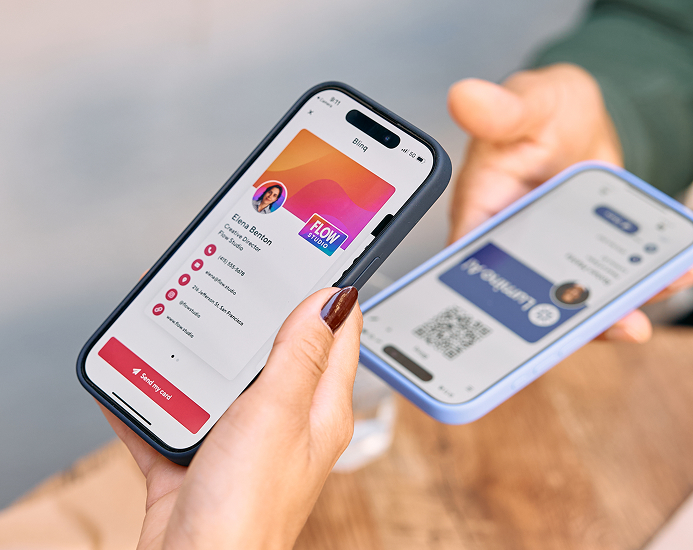Key Takeaways

We’ve all been there: exchanging business cards at an event, only to realize you’ve misplaced them or your details have changed. As we move through 2025, the way we share professional information is evolving rapidly, and you're probably wondering, what are the best alternatives to printed business cards?
Digital business cards are emerging as the modern standard, as 37% of small businesses and 23% of individuals use them to build connections. This shift isn't just a trend, it's a transformation of how we connect professionally that offers greater flexibility, sustainability, and tracking capabilities that paper cards simply can't match.
Note: if not attributed directly, statistics in this article are sourced from industry benchmarks and public case reports from enterprise rollouts.
Why Traditional Business Cards Are Becoming Obsolete
Paper business cards have served us well for decades, but their limitations are increasingly apparent in today's digital landscape:
Limited Information Capacity
A standard 3.5" x 2" card can only hold so much information. Your job title, email, and phone number might fit, but what about your portfolio, case studies, or social profiles?
Environmental Impact
The environmental cost is substantial. Around 100 billion business cards are printed annually, which results in the harvesting of 6 million trees. Plus, 88% of paper business cards are thrown away within a week of being received, which results in significant waste for minimal returns.
Reprinting Costs
When your information changes (due to a new role, address or company), you're forced to throw away your current cards and get them reprinted. Businesses report up to a 90% reduction in printing and distribution costs by switching to digital business cards.
Lack of Trackability
Once you hand out a paper card, there's no way to know if the recipient looked at it, saved your details, or simply tossed it. Digital alternatives provide valuable insights into how people interact with your contact information.
Pandemic-Accelerated Change
COVID-19 dramatically accelerated this transition, with a reported 70% drop in traditional business card printing post-pandemic, making digital alternatives not just preferential but often necessary.
Digital Business Cards: The Modern Standard
Digital business cards represent the most comprehensive alternative to paper cards. They're essentially online profiles containing your professional information that can be shared instantly via QR codes, NFC technology, links, or messaging apps.
How They Work
Digital business cards allow you to:
- Create a professional profile with all your contact details
- Share via QR code, tap (NFC), or direct link
- Update information in real-time
- Track engagement and interactions
- Integrate with CRMs and other business tools
The market for these solutions is growing rapidly, and is projected to reach $242m by 2027.
Top Alternatives to Paper Business Cards
1. Digital Business Cards
Digital business cards offer the most direct replacement for traditional cards while providing enhanced functionality:
Sharing Options
- QR Code: Recipients scan with their smartphone camera – no app required
- NFC: Tap your digital card (or phone) to share instantly with compatible devices
- Link Sharing: Send your card via email, text, or social media
The technology you choose matters. QR codes work with virtually any smartphone, but require scanning, while NFCs offer a seamless tap experience, but only work with NFC-enabled devices. App-based solutions provide the most features but may require recipients to have an internet connection.
Wallet Integration
Modern digital business cards can be added to Apple or Google Wallet, making them accessible even without an internet connection.
Analytics Capabilities
Unlike paper cards, digital solutions let you see valuable analytics for follow-ups and in-person leads, like who viewed your card, saved your details, or clicked on specific links.
CRM Integration
Digital business cards can integrate with customer relationship management systems like Salesforce, HubSpot, and Microsoft Dynamics 365. These integrations automate contact capture, ensure up-to-date CRM records, and enable advanced workflow automation to streamline lead management and boost sales productivity.
2. Social Media Profiles
While not a complete replacement for business cards, optimized social profiles can serve as effective alternatives:
As the world's largest professional network, LinkedIn serves as a de facto business card for many. Share your profile by:
- Creating a custom LinkedIn QR code
- Using the "Find Nearby" feature at in-person events
- Adding your LinkedIn URL to email signatures
Most professionals are already on LinkedIn, which is a big advantage, but there’s limited customization options and recipients need to have an account to receive details.
3. Email Signatures
Email signatures are often overlooked as business card alternatives, Modern email signatures can include:
- Your complete contact information
- Social media links
- Calendar booking links
- Digital business card QR codes
- Company branding
4. QR Codes for Your Website or Portfolio
For those who prefer directing contacts to existing web presences:
Website QR Codes
Create a QR code that links directly to:
- Your personal website
- Portfolio page
- Contact form
- "About me" section
This approach utilizes existing assets but lacks the portable, offline capabilities of dedicated digital business cards.
5. Contact Sharing Apps
Beyond dedicated digital business card platforms, several contact sharing apps facilitate professional connections:
Universal Contact Apps
These apps focus on contact management rather than presentation, and:
- Allow quick sharing of contact information
- Typically require both parties to have the app installed
- May offer fewer branding and customization options
The primary disadvantage is the requirement for recipients to download the same app, creating friction when trying to form new connections.
Making the Transition: From Paper to Digital
Shifting from traditional to digital business cards requires some adjustment:
For Individuals
- Start with your current information: Transfer all existing business card data
- Enhance with digital extras: Add social links, portfolio pieces, and videos
- Create a sharing routine: Practice QR code sharing or NFC tapping
- Track engagement: Use analytics to see who's viewing your information
For Teams
- Select a platform with central management: Look for platforms that offer admin control panels
- Standardize branding: Ensure consistent logos, colors, and formats
- Implement single sign-on: Use enterprise authentication for security
- Integrate with existing tools: Connect with your CRM, email, and HR systems
63% of millennials already prefer digital business cards over traditional ones, citing ease of use and eco-friendliness as primary reasons. Meanwhile, Gen Z shows strong receptivity with their digital-native status and preference for integrated, mobile-first solutions.
When Digital Alternatives Shine Brightest
Certain scenarios particularly highlight the advantages of digital alternatives:
Trade Shows and Conferences
Digital business cards excel in high-volume environments where:
- You meet dozens or hundreds of people
- Follow-up is critical
- Different team members need to share consistent information
- Analytics help prioritize leads
Global and Remote Connections
For international business where:
- Contacts span multiple countries
- Time zones complicate follow-up
- Language options may be needed
- Physical card shipping is impractical
Sales and Business Development
When conversion metrics matter:
- Track which prospects viewed your information
- Integrate with sales pipelines
- Update details without reprints
- Share different card versions based on client segments
Measuring Success: Beyond the Handshake
Digital alternatives offer metrics that paper cards never could:
Engagement Analytics
Track how contacts interact with your information through:
- View counts and duration
- Link clicks
- Media engagement
- Form submissions
ROI Comparison
Companies report significant benefits after switching from paper to digital:
- Up to 90% reduction in printing and distribution costs
- Elimination of reprint waste when information changes
- Time savings from automated integration with other systems
- Higher connection retention rates
Environmental Impact
Sustainability benefits include:
- Reduced paper consumption
- Lower carbon footprint from printing and shipping
- Alignment with corporate sustainability goals
- Appeals to eco-conscious clients and partners
The Future of Connections: Beyond 2025
Looking ahead, digital business cards will continue evolving:
Blending Physical and Digital
Physical cards with embedded NFC chips or distinctive QR codes will bridge the gap for traditionalists while offering digital benefits.
Integration with Emerging Technologies
By 2027, expect deeper integration with:
- Augmented Reality: Creating immersive profile experiences
- Virtual Reality: For virtual networking spaces and portfolio showcases
- Blockchain: Enhancing security and credential verification
- Advanced AI: For deeper personalization and follow-up automation
Making the Switch
So, what are the best alternatives to printed business cards? Digital business cards clearly lead the pack, offering comprehensive features, seamless sharing, and valuable analytics that physical cards can't match.
Whether you're a tech-forward millennial, a digital-native Gen Z professional, or a Gen X leader ready to modernize how you connect with others, digital alternatives offer compelling advantages for anyone looking to connect professionally in 2025 and beyond.
Ready to elevate your networking? Explore Blinq's secure digital business card options and take control of how you share your information.






